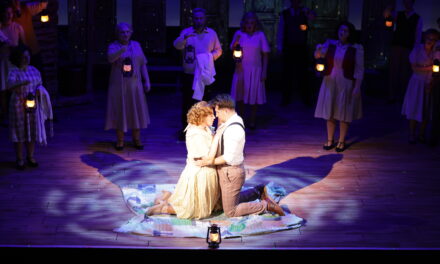
Anne Frank (Becca Ingram)
PROVO — I saw a play at BYU,The Diary of Anne Frank, which has to be the most read diary in the world. Everybody knows the story of a little girl who was forced into hiding, shut behind a bookcase with her family during World War II. People may not know all of the details, like the fact that there were eight people living in those small rooms for over two years, that they had to be absolutely silent during the day to avoid being heard by men working in the factory below, or that after being sent to Auschwitz, Anne, her sister and her mother were sent to the Bergen-Belsen concentration camp where Anne died of typhus just weeks before the Allies liberated that camp. Still, most people are generally familiar with the history of Nazi Germany during World War II and the many atrocities associated with the Holocaust. But it is different to hear it described by an upbeat, optimistic, cheerful young girl who was first-hand witness to its effects.
The first thing that strikes you as you enter the Pardoe theatre at BYU is the size of the Eric Fielding‘s set: it is extremely small, but extremely well-designed. A two-story attic apartment with very small rooms that barely contains all of the actors who remain on stage for most of the production. It really gives you a feel for what it must have been like to live like that for such a long time. I was feeling claustrophobic for them only watching the play for a little over an hour and a half. The sides of the set are slanted with tiles and windows, representing the roof of the factory in which the Frank and Van Daan families spent their time. These spaces were not simply for decoration, though, as historical information and video clips and pictures were projected onto these walls during the preshow, intermission, and during scene breaks helping to give a context to the events of the play and to provide the historical background.
Director David Morgan‘s inclusion of this historical information was great because it was surprisingly missing from the actual play, which focuses more on young Anne and her relationship with her family and the others staying with them. Essentially, this is less a historical play and more a play about how a girl deals with growing up in a very difficult situation. Becca Ingram played Anne’s youthful, hopeful energy wonderfully, bringing this teenage girl’s words to life in a such a way that she became a real person and not just a name that we’ve all heard so often.
As Frances Goodrich and Albert Hackett‘s script progresses, we get to see young Anne Frank as a real young girl, with a young girl’s real problems, compounded somewhat by being stuck in hiding, afraid for her life. We see her argue with her mother, played by Ashley Bonner, and we see her turn to her father, played by Jeff Dickamore. And we see Anne develop a friendship and the beginnings of a romantic relationship with Peter Van Daan, played by Graham Ward, whose family is in hiding with them.
This play is not really about the Holocaust, it is not really about a Jewish family hiding from the Nazis in Amsterdam, it is not really about the tragedy of World War II. It is about hope and family and growing up. It is about youthful optimism in a world that says nothing good can ever happen again. It is about finding something to be happy about no matter where you are or how bad things seem. This Diary of a Young Girl that has been such an inspiration to millions is still helping audiences ask the hard questions and ponder the answers.
As I was leaving the theatre after the show, I heard a boy of about 10 ask his father, “But, why did they do it?”, to which his father could only respond, “That’s a very good question.” And that is why this play, and the book it is based on, are still so successful and popular. It begs us to ask these questions. Why did the Nazis do what they did? Why does such cruelty and inhumanity exist in the world? And what am I going to do about it when I encounter it? What can I do to end or prevent similar atrocities that happen throughout the world?
BYU has a fine production, made even better by the use of technology and media to help the audience understand the context and the meaning of the play. This was supplemented by the use of music provided by Jennifer Chandler, a cellist who sat on stage playing eerily beautiful accompaniment. All of the actors did a wonderful job of bringing their characters to life, showing the complexity of the piece, being both humorous and deathly serious. The only detriment was the fact that the actors tried to use accents. Sometimes they spoke with German accents, sometimes slipping into an Irish brogue (which Becca Ingram used remarkably well when BYU did Dancing at Lughnasa in 2008), and sometimes the accents disappeared completely. It was just a little distracting, but not overly so, and the overall quality of the production did not suffer much because of it.
A great play does not just entertain for an evening but seeks to give its audience something to think about and take with them as they leave the theatre. BYU’s production of The Diary of Anne Frank does exactly this.

Mr. Frank (Jeff Dickamore), Mrs. Frank (Ashley Bonner), Margot Frank (Brittany Stahly), Anne Frank (Becca Ingram), Mr. Van Daan (Adam Meyer), Mrs. Van Daan (Carla Kirk), Peter Van Daan (Graham Ward)




